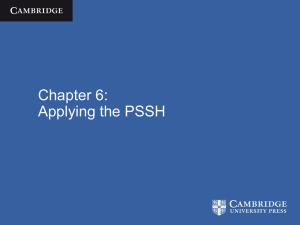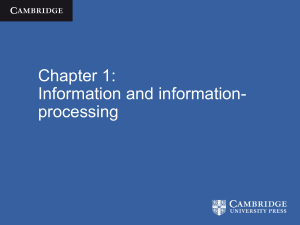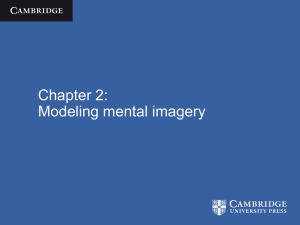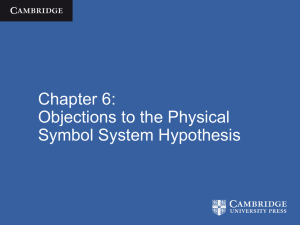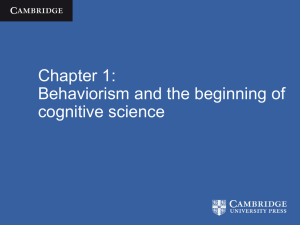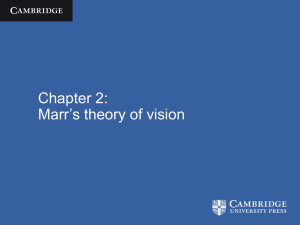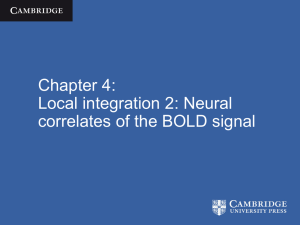Cognitive science and the integration challenge
advertisement
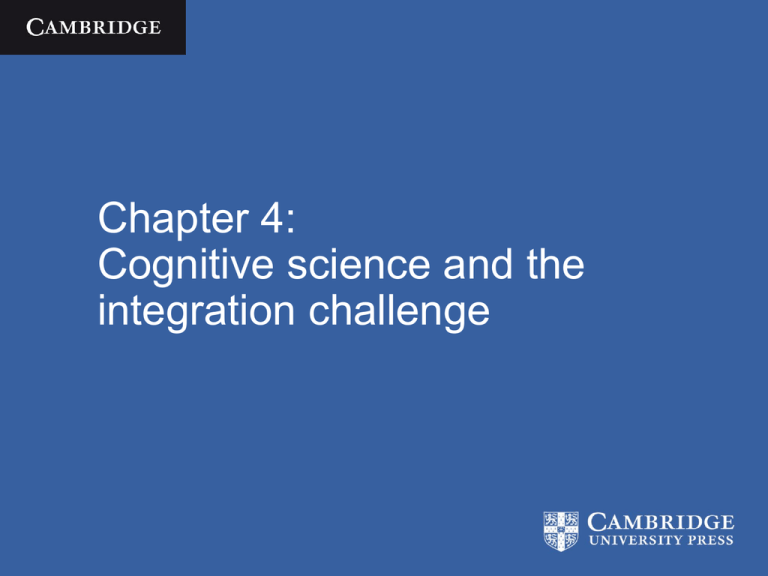
Chapter 4: Cognitive science and the integration challenge Overview • Review multiple choice questions on class test • Bring out some of the key features and themes of our historical overview • Introduce integration challenge • Sketch out the next stages of the course Cognitive Science José Luis Bermúdez / Cambridge University Press 2010 Question 1 1. According to Marr, which of the following are involved in giving a computational-level analysis of an information-processing system? (a) Specifying what the system is doing—its basic task. (b) Specifying the representational format of the system’s inputs and outputs. (c) Specifying the algorithm the system uses to compute. (d) a and b (e) b and c (f) a and c Cognitive Science José Luis Bermúdez / Cambridge University Press 2010 Question 2 2. According to Miller, the advantage of recoding in an immediate memory task is that it does which of the following? (a) Increases the chunks per bit of information. (b) Increases the bits per chunk of information. (c) Increases the span of absolute judgment. (d) Increases the span of perceptual dimensionality. (e) None of the above. Cognitive Science José Luis Bermúdez / Cambridge University Press 2010 Question 3 To parse a sentence such as “Put the red block on top of the blue block on the table” SHRDLU would do which of the following? (a) Examine the micro-world before beginning syntactic processing. (b) Identify all syntactically possible options, then use information about the micro-world to identify semantically possible options. (c) Disambiguate the sentence by asking a question. (d) Identify a syntactically possible option, then use information about the micro-world to evaluate whether it is semantically possible. Cognitive Science José Luis Bermúdez / Cambridge University Press 2010 Question 4 Why is it acceptable to appeal to addition when specifying an algorithm for multiplication? (a) Because there is only one algorithm for addition. (b) Because every Turing machine can compute the addition function. (c) Because addition is an algorithmic operation. (d) Because addition is built into the machine table of every Turning machine. (e) None of the above. Cognitive Science José Luis Bermúdez / Cambridge University Press 2010 Question 5 5. Some cognitive scientists interpreted Shepard & Metzler’s results as evidence for non-digital information coding because. . . (a) The operations defined over digitally coded information should be too complex to perform. (b) The processing time for digitally coded information should be a function only of the amount of information encoded. (c) It should not be meaningful to perform the rotation operation on digitally coded information. (d) a and b (e) b and c (f) a and c Cognitive Science José Luis Bermúdez / Cambridge University Press 2010 What is cognitive science? • Is there such a thing as cognitive science (as opposed to the cognitive sciences)? • Are there any basic assumptions about the mind that unify all the different models and approaches we have been considering? • Does cognitive science have a distinctive methodology? Cognitive Science José Luis Bermúdez / Cambridge University Press 2010 An early model • Identifies connections between different cognitive sciences, but sheds no light on why there need to be such connections • Doesn’t help us to understand what each discipline contributes • Doesn’t give a very accurate picture of contemporary cognitive science Cognitive Science José Luis Bermúdez / Cambridge University Press 2010 Two basic assumptions (1) The mind is too complicated to be understood using the resources of any discipline on its own • Need for interdisciplinarity (2) The mind has to be understood at many different levels Need for an integrated multilevel explanation Cognitive Science José Luis Bermúdez / Cambridge University Press 2010 The example of neuroscience Neuroscience has evolved enormously since the early days of cognitive science It is itself highly interdisciplinary and multilevel Illustrates the close connection between • levels of organization • levels of explanation • available scientific tools and techniques Cognitive Science José Luis Bermúdez / Cambridge University Press 2010 Levels of explanation A B C D E-H Cognitive Science José Luis Bermúdez / Cambridge University Press 2010 Experimental psychology Cognitive neuroscience Behavioral neuroscience Systems neuroscience Cellular neuroscience Molecular neuroscience Tools and levels in neuroscience Cognitive Science José Luis Bermúdez / Cambridge University Press 2010 Organization in psychology • Scientific psychology is not organized vertically in terms of levels • Instead organized horizontally in terms of domains MIND AND BEHAVIOR AT THE LEVEL OF THE ORGANISM General cognitive capacities COGNITIVE PSYCHOLOGY Cognition in a social context SOCIAL PSYCHOLOGY Individual personality and character PERSONALITY PSYCHOLOGY Cognitive Science José Luis Bermúdez / Cambridge University Press 2010 Non-human cognition COMPARATIVE PSYCHOLOGY How cognitive abilities develop DEVELOPMENTAL PSYCHOLOGY Cognitive Science José Luis Bermúdez / Cambridge University Press 2010 The integration challenge •The challenge of providing an unified account of cognition that draws upon and integrates the whole space • Many regions within the “space” of cognitive science remain little studied • The “space” is not organized by discipline Cognitive Science José Luis Bermúdez / Cambridge University Press 2010 3 approaches to IC Local integrations • Examples of specific cases where cognitive scientists have built bridges across levels of explanation and between disciplines Global models of integration • Blueprints for solving the integration challenge The mental architectures approach Cognitive Science José Luis Bermúdez / Cambridge University Press 2010 Local integration 1 • Inspired by experiments in the psychology of reasoning showing that people are systematically prone to very specific types of fallacies in deductive reasoning • Evolutionary psychologists suggest that these patterns of error are by-products of highly specialized cognitive mechanisms that emerged to solve adaptive problems • massive modularity thesis • cheater detection module Cognitive Science José Luis Bermúdez / Cambridge University Press 2010 Local integration 1 •Solution of adaptive problems Explains •Emergence of dedicated cheater detection system Explains •Patterns of error in logical reasoning tasks Cognitive Science José Luis Bermúdez / Cambridge University Press 2010 Local integration 2 •Cognitive scientists often treat functional neuroimaging as if it provides direct “map” of the mind in action •But neuroimaging directly measures blood flow (PET) or levels of blood oxygen (fMRI) – whereas the “motor” of cognitive activity is neuronal activity •How do we integrate BOLD signal information with information about neuronal activity? Cognitive Science José Luis Bermúdez / Cambridge University Press 2010 Local integration 2 •Research question: What are the neural correlates of the BOLD signal? •Experiments by Logothetis explored this question by calibrating fMRI data with microelectrode recording • bridging levels of organization and levels of spatial resolution • allowed fMRI data to connect up with neural models (and computational neuroscience) Cognitive Science José Luis Bermúdez / Cambridge University Press 2010 Models of global integration Two main candidates: • Marr’s tri-level hypothesis - explicitly proposed as a way of bridging different levels of explanation • Models of inter-theoretic reduction derived from philosophy of science – analogy with unity of science hypothesis in the physical sciences Cognitive Science José Luis Bermúdez / Cambridge University Press 2010 Mental architectures approach Starts off from the basic assumption that cognition is a form of information-processing Assumption governs all levels of organization (from neurons upwards) and almost all explanatory models/hypothesis within the individual cognitive sciences But there is relatively little discussion w/in those disciplines of how information and information-processing are to be understood Cognitive Science José Luis Bermúdez / Cambridge University Press 2010 Mental architecture A mental architecture is a model of how the mind is organized and how it works to process information 1) In what format does a cognitive system carry information? 2) How does that system transform and process information? 3) How is the mind as a whole organized into informationprocessing sub-systems? Cognitive Science José Luis Bermúdez / Cambridge University Press 2010 Timetable •Evolutionary psychology Wednesday 9-30 •BOLD signal Friday 10-2 •Global models & mental architectures Monday 2-5 Cognitive Science José Luis Bermúdez / Cambridge University Press 2010 Two models of informationprocessing The physical symbol system hypothesis • e.g. Turing machine model of informationprocessing • associated with classical, symbolic AI Connectionism/artificial neural networks • neurally-inspired models of informationprocessing • used to model cognitive/perceptual abilities that posed problems for classical AI Cognitive Science José Luis Bermúdez / Cambridge University Press 2010 have
